Management Of Discolored Teeth Important Notes
- Management Of Discolored Teeth Superoxol
- It is 30% solution of hydrogen peroxide by weight and 100% by volume in pure distilled water
- It is mixed with sodium perborate into a paste and used in walking bleach technique
- Management Of Discolored Teeth Bleaching techniques:
- Non vital bleaching technique
- Thermocatalytic
- It involves the placement of 35% hydrogen peroxide liquid into the debrided pulp chamber and acceleration of the oxidation process by heating instrument into pulp chamber.
- Walking bleach
- In this technique, superoxol is used
- Thermocatalytic
- Vital bleaching technique
- Power bleaching
- 35% hydrogen peroxide is used and oxidation is acceletated by applying heat or intense light
- Night guard bleach
- 10-15% carbamide peroxide is applied with the help of bleaching trays
- Power bleaching
- Non vital bleaching technique
- Management Of Discolored Teeth Composition of Mc Inns solution.

Management Of Discolored Teeth Long Essays
Question 1. Management of discolored teeth
Answer.
Causes Of Discolored Teeth Intrinsic Stains:
- Pre-Eruptive Causes:
- Disease-Haematological disorders
- Medication-tetracycline
- Post-Eruptive Causes:
- Pulpal changes
- Trauma
- Aging
- Dental caries
Read And Learn More: Endodontics Question and Answers
Causes of Discolored Teeth Extrinsic Stains:
- Daily Acquired Stains:
- Plaque
- Tobacco use
- Poor oral hygiene
- Gingival hemorrhage
- Chemicals:
- Chlorhexidine
- Metallic stains
Bleaching Is Done To Treat Discolored Teeth
Bleaching: Bleaching is a procedure that involves lightening the color of a tooth through the application of a chemical agent to oxidize the organic pigmentation in the tooth.
Bleaching Techniques:
- For vital teeth
- Home bleaching
- In-office bleaching
- Thermocatalytic
- Non-thermocatalytic
- Microabrasion
- For non-vital teeth
- Thermocatalytic
- Walking bleach
- Inside/Outside
- Closed chamber
- Laser-assisted bleaching
Nightguard Bleaching Indications:
- Mild generalized
- Age-related
- Mild fluorosis
- Mild tetracycline staining
- Superficial staining
- Stains from smoking tobacco
Bleaching Contra-Indications:
- Teeth with insufficient enamel
- Severe fluorosis
- Non-complaint patients
- Pregnancy
- Severe tetracycline staining
- Fractured tooth
- Opaque white spots
Bleaching Steps:
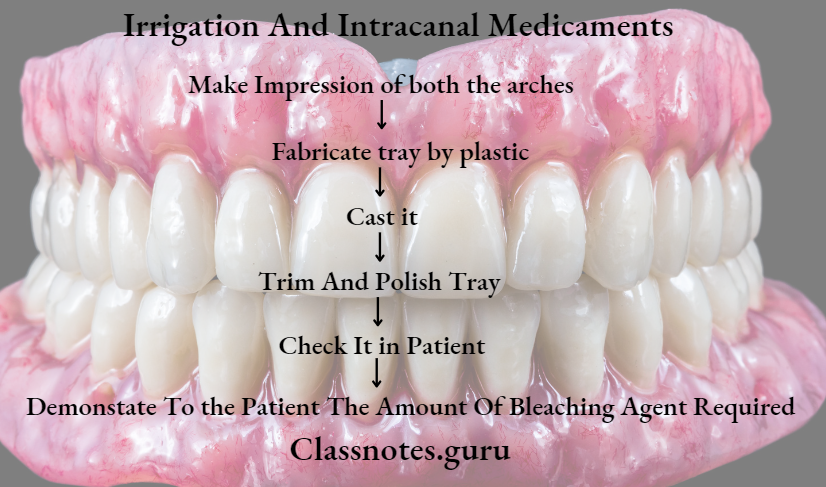
Bleaching Agents Used:
- 10% carbamide peroxide
- 15% carbamide peroxide
- Hydrogen peroxide
Bleaching Side Effects:
- Gingival irritation
- Altered taste sensation
- Tooth Sensitivity
Management Of Discolored Teeth
Management Of Discolored Teeth Short Essays
Question 1. Vital bleaching.
Answer.
In-office bleaching:
- It uses 35% hydrogen peroxide solution
Vital Bleaching Indications:
- Mild fluorosis
- Mild tetracycline stains
- In severe discoloration
- To match the existing color of the crown that is lighter than natural teeth
Vital Bleaching Contraindications:
- Superficial stains
- Carious tooth structure
- Hypersensitive teeth
- Children with a large pulp chamber
- Pregnant and lactating mothers
- Exposed root surfaces
Vital Bleaching Technique:
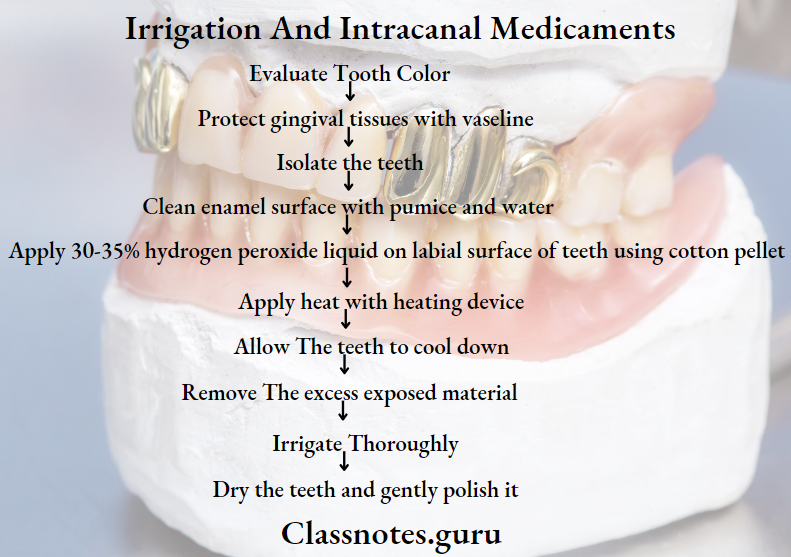
At-Home Bleaching Indications:
- Superficial enamel discolorations
- Mild yellow discolorations
- Brown fluorosis discolorations
- Age-related discolorations
At-Home Bleaching Contraindication:
- Severe enamel loss
- Hypersensitive teeth
- Bruxism
- Presence of caries
- Defective coronal restorations
- Allergy to bleaching gels
At-Home Bleaching Technique:
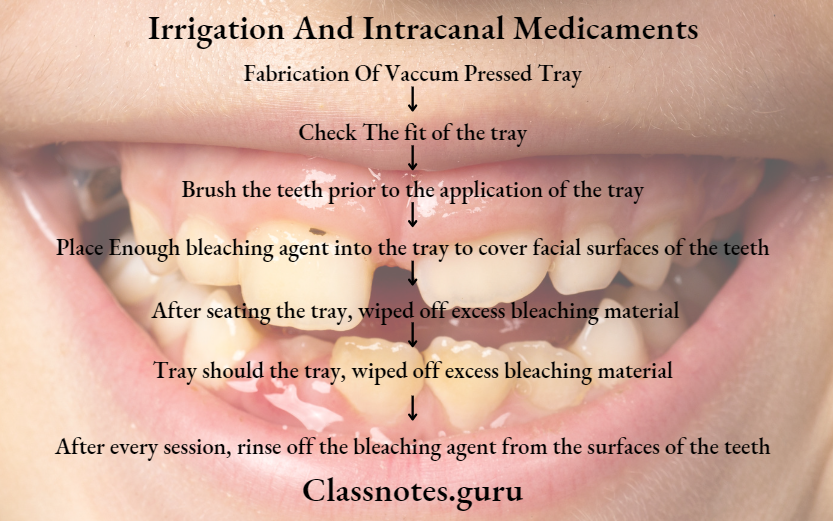
Question 2. Carbamide peroxide
Answer:
Carbamide Peroxide Definition
- Carbamide Peroxide is also known as urea hydrogen peroxide
- Carbamide Peroxide concentration ranges from 3-45% depending on at-home and in-office bleach
- Commonly 10% carbamide peroxide is used
Carbamide Peroxide Mechanism Of Action
- Carbamide Peroxide→Urea + Ammonia + carbon dioxide + 3.5% hydrogen peroxide
Teeth Discoloration Treatment
Question 3. Thermocatalytic Bleaching.
Answer.
Thermocatalytic Bleaching Light Sources Used:
- Conventional
- Tungsten halogen
- Xenon plasma
- Argon and Co2
- Diode laser
Thermocatalytic Bleaching Indication:
- Superficial stains
- Mild to moderate stains
Thermocatalytic Bleaching Contraindications:
- Extensive restoration
- Severe discoloration
- Extensive caries
Thermocatalytic Bleaching Advantages:
- Comfortable to patient
- Less time needed
- Safe
Thermocatalytic Bleaching Disadvantages:
- Expensive
- Frequent
- Dehydration of teeth
- Rubber dam discomfort.
Thermocatalytic Bleaching Procedure:
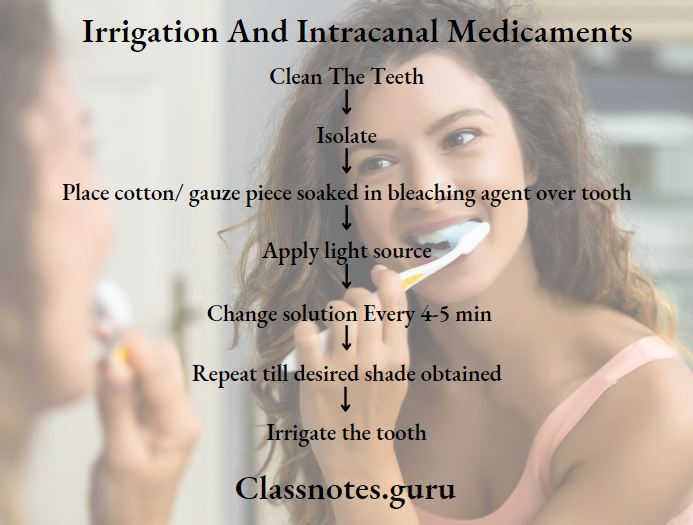

How To Whiten Stained Teeth
Question 4. Microabrasion.
Answer.
Microabrasion
In it, a microscopic layer of enamel is eroded and abraded with solution leaving intact enamel.
Microabrasion Indications:
- Intrinsic stains
- Hypomineralised enamel
- Decalcification
- Enamel fluorosis
- Superficial stains
Microabrasion Contra-Indications:
- Age-related
- Hypoplastic lesions
- Deep stains
- Tetracycline staining
Microabrasion Advantages:
- Minimum discomfort
- Easy
- Results in shiny and smooth surface
Microabrasion Disadvantages:
- Ineffective for deeper stains
- Removes enamel layer
Microabrasion Steps:
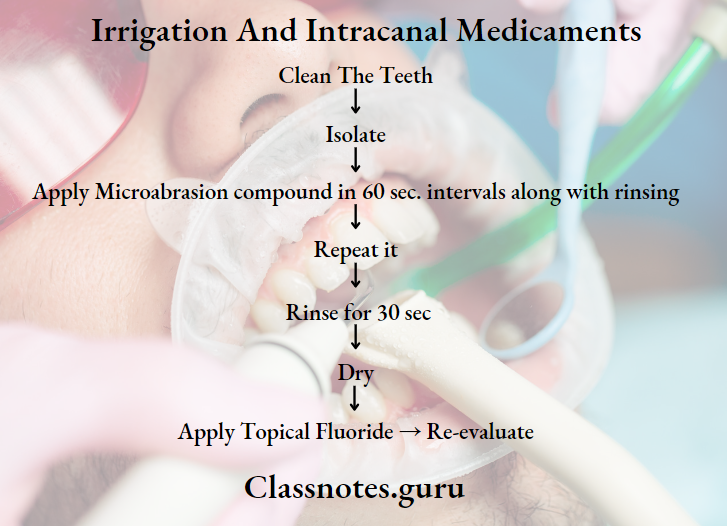
Question 5. Bleaching of non-vital tooth.
Answer.
Bleaching Of Non-Vital Tooth – Thermocatalytic Technique:
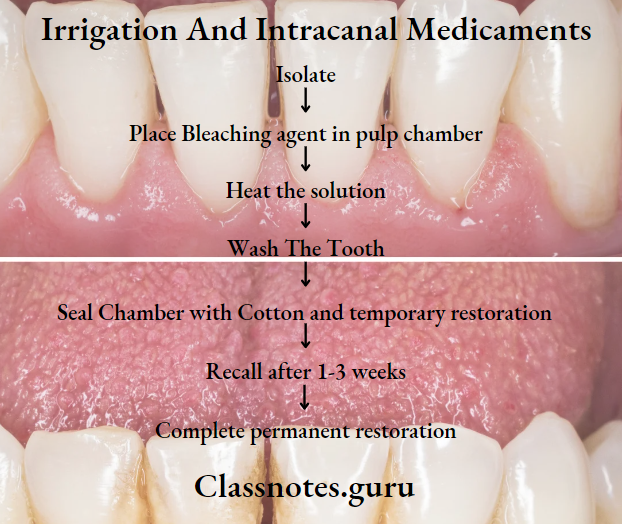
Bleaching Of The Non-Vital Tooth – Walking Bleach technique:
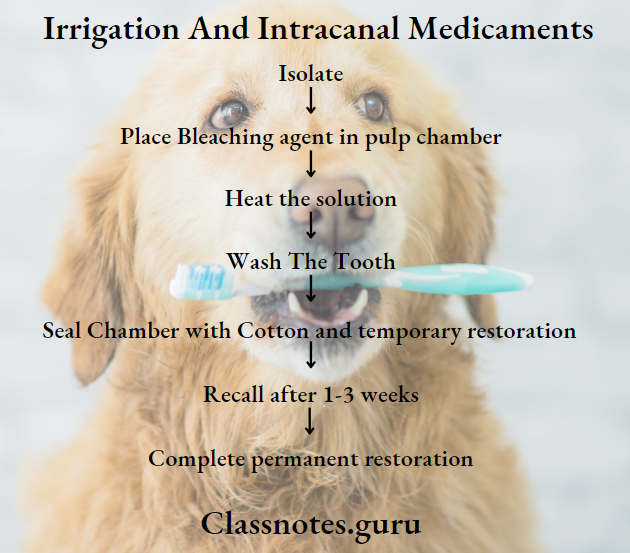
Bleaching Of The Non-Vital Tooth- Inside/Outside Bleaching:
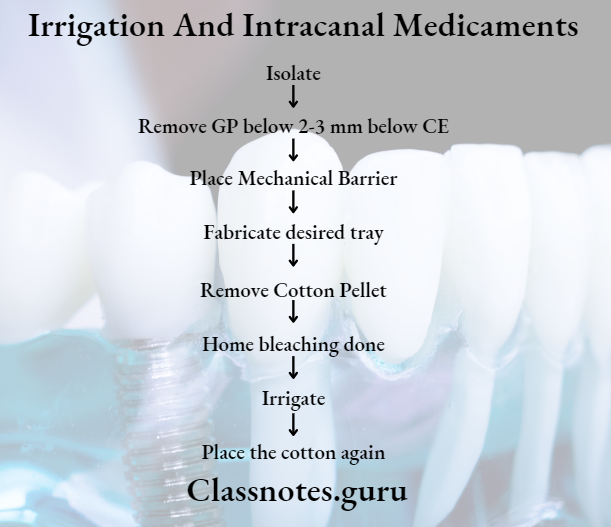
Closed Chamber:
- Bleaching paste was applied to the tooth via a bleaching tray
Intrinsic vs. extrinsic Tooth Stains
Question 6. Walking Bleach.
Answer.
Walking Bleach Indications:
- Discoloration of the pulp chamber
- Moderate to severe tetracycline staining
- Dentin discoloration
Walking Bleach Contraindications:
- Defective enamel
- Enamel discoloration
- Presence of caries
Walking Bleach Steps:
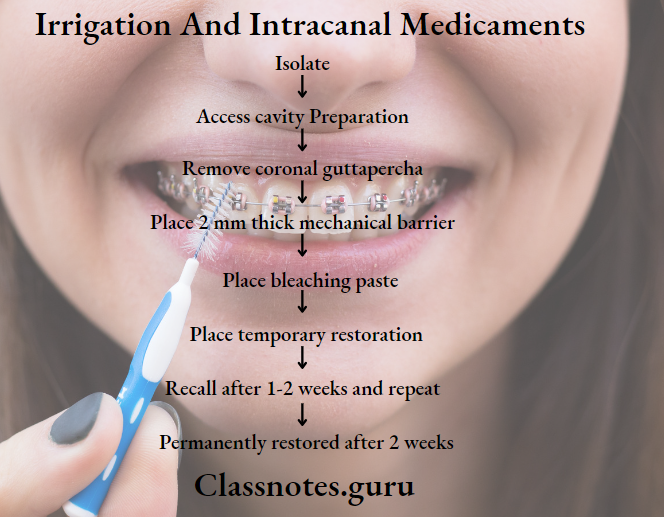

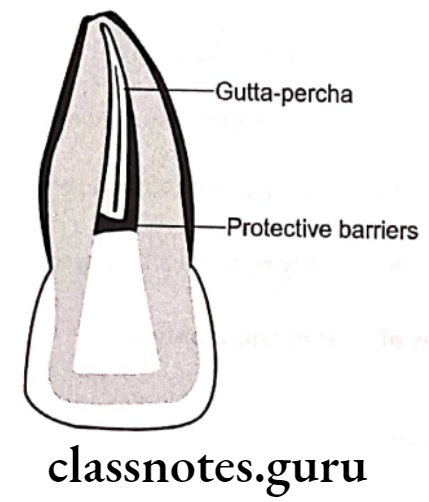

Endodontic Bleaching Techniques
Question 7. Microbrasion and macrobrasion.
Answer.
Microbrasion And Macrobrasio
In it a microscopic layer of enamel is eroded and abraded with solution leaving intact enamel.
Microbrasion Indications:
- Intrinsic stains
- Hypomineralised enamel
- Decalcification
- Enamel fluorosis
- Superficial stains
Microbrasion Contra-Indications:
- Age-related
- Hypoplastic lesions
- Deep stains
- Tetracycline staining
Microbrasion Advantages:
- Minimum discomfort
- Easy
- Results in shiny and smooth surface
Microabrasion Disadvantages:
- Ineffective for deeper stains
- Removes enamel layer
Microabrasion
- Microabrasion involves using of dental drill and finishing bur to remove stains
- In this composite finishing bur is used on a high speed hand piece to remove the defect
- While working on the defect very light pressure is applied to prevent any irreversible damage to the tooth
- The process is finished with abrasive rubber point
- During the process air water spray is used to maintain the temperature and to keep the tooth hydrated
Management Of Discolored Teeth Short Questions And Answers
Question 1. Causes of Discoloration of tooth.
Answer.
Discoloration Of Tooth Intrinsic Stains:
- Pre-eruptice causes:
- Disease-Haematological disorders
- Medication-tetracycline
- Post-Eruptive Causes:
- Pulpal changes
- Trauma
- Aging
- Dental caries
Discoloration Of Tooth Extrinsic Stains:
- Daily Scquired Stains:
- Plaque
- Tobacco use
- Poor oral hygiene
- Gingival haemorrhage
- Chemicals
- Chlorhexidine
- Metallic stains
Management Of Discolored Teeth
Question 2. Mc-Innes Solution.
Answer.
Mc-Innes Solution Composition:
- 30% Hydrogen peroxide – 5 parts
- 36% hydrochloric acid – 5 parts
- Anesthetic ether – 1 part
Mc-Innes Solution Method:
Apply the solution with a cotton pellet to the stained area and allow it to remain for 5-10 minutes
Question 3. Superoxol
Answer.
Superoxol
- Superoxol is a 30% solution of hydrogen peroxide by weight in 100% volume of distilled water
- Superoxol is a powerful oxidizing agent
- Superoxol is highly irritating of the soft tissues
Question 4. Uses of laser in endodontics
Answer.
Uses Of Laser In Endodemtics
- Diagnosis
- Laser Doppler flowmetry – to assess blood flowmetry
- Nd:YAG laser – for vitality test
- Pulp capping and Pulpotomy
- To treat exposed pulp tissues using Co2 lasers
- Root canal treatment
- To modify root canal walls
- Sterilization of root canals
- Treatment of incomplete fracture
- Apicoectomy
- Treatment of dentinal hypersensitivity
- Sterilization of instruments
- Bleaching
